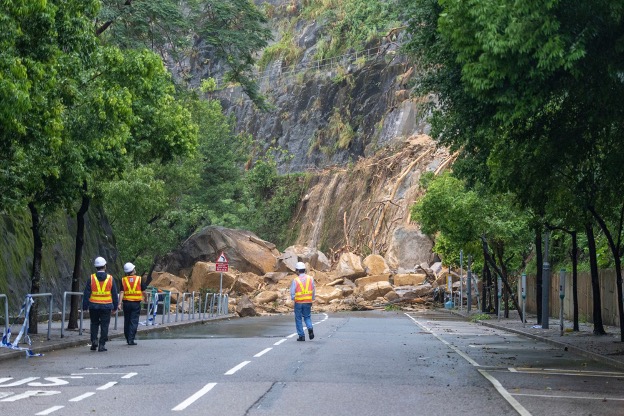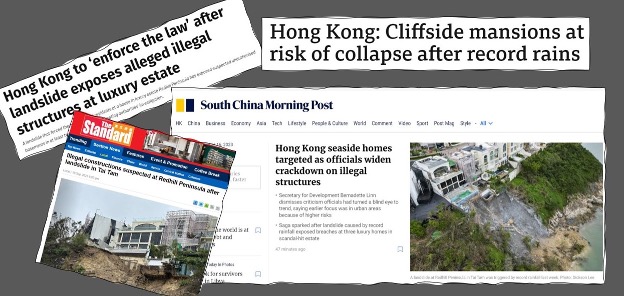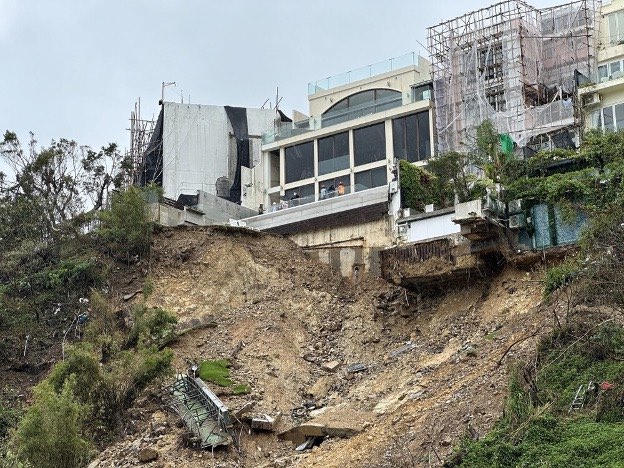Hong Kong has historically been vulnerable to landslides because many people have built their homes on hilly terrain due to housing pressures, and the region has high levels of seasonal rainfall, making these slopes unsafe and liable to collapse. The Redhill Peninsula landslide was a major event that occurred in Hong Kong on September 7, 2023, following record-breaking rainfall brought by Typhoon Saola.
Landslides are a significant natural hazard that can have devastating effects on human lives, infrastructure, and the environment. Without proactive management of landslide risk Hong Kong’s recent extreme rainstorm would have caused much more devastation, writes the leader of Arup’s engineering geology team in Hong Kong, Stuart Millis. Three houses were directly affected, with portions of their gardens and cliffs collapsing into the sea.
Learning from Hong Kong’s approach to landslide risk management Without proactive management of landslide risk Hong Kong’s recent extreme rainstorm would have caused much more devastation, writes the leader of Arup’s engineering geology team in Hong Kong, Stuart Millis. Although the rainfall during the typhoon was not especially noteworthy (around 150mm), it still exceeded the entire monthly rainfall in August 2023. The typhoon also caused significant disturbance of vegetation, which will have started to clog up drainage channels.
The sheer Intensity of the storm on the 7/8 September 2023, coupled with a groundmass that had been pre-saturated a short while before, resulted in conditions that were primed for land sliding. Although notable throughout most of the territory, the most significant concentrations of rainfall were over the eastern parts of Hong Kong Island, where the 24 hour rainfall rate exceeded 900mm, as well as Kowloon and the Central New Territories. So essentially, the storm hit many of the most densely developed urban areas of the Hong Kong Special Administrative Region (HKSAR).

Yiu Hing Road Landslide
The landslide at Yiu Hing Road was by far the largest and most prominent of the failures that occurred during the rainstorm. Whether it was the most significant is open to debate, especially if you happen to be a resident in south eastern Hong Kong Island (Shek O), which was cut off for over 24 hours due to landslides damaging the sole access road, or living in one of the houses at the nearby Red Hill Peninsula in Tai Tam, where large coastal slope landslides undermined several properties.
This is rather fortunate, given the time that will no doubt be required to make the area safe once again. It occurred within an area of densely vegetated natural hillside directly above a large pre-existing soil and rock cut slope that is about 55m high. The geology in this part of Hong Kong comprises fine-to-medium grained granite, with the bedrock strata overlain by a mantle of saprolite (in-situ weathered strata) that generally varies between 3m to 10m in thickness based on the available nearby ground investigation data. Exposed rock is apparent in the drainage lines either side of the interfluve on which the landslide occurred.
At that time, no one has been able to safely access the landslide scar for a detailed look due to the continued heavy rain. As such, only preliminary interpretations from drone photographs and their associated photogrammetric models can be made.
However, initial measurements from photogrammetric models of the landslide we’ve built over the last few days show the main body of the scar to be about 25m to 30m wide, about 40m to 50m plan length and with depths between about 3m to 5m, all of which suggests that over a 1,000m3 of material was mobilised. The orientation and high persistence of the discontinuity at the rupture surface, together with the notable presence of other discontinuities with similar conditions elsewhere throughout the hillside, is suggestive of the feature being a sheeting joint.
The groundmass above this was most likely mobilised as a result of the build-up of high transient porewater pressures along the sheeting joint. This build-up of porewater pressure would have reduced the effective stress along the joint surface to the point where shearing was initiated and the overlying sheeting slabs and weathered material were mobilised downslope.
Although it’s hard to say with any certainty until the scar has been inspected in detail, notable areas with a lighter hue are apparent on the rupture surface suggesting the possible presence of kaolin on the joint surface, which would have further reduced its shear strength. The presence of kaolin-rich zones and kaolin infill in low angle discontinuities (e.g. sheeting joints) in the zones close to the weathering front is not uncommon and has been observed in several highly notable past landslides such as those at Shum Wan Road (1995) and Fei Tsui Road (1995).

Risk Factors
The main factor contributing to landslide risk in Hong Kong is the proximity of infrastructure and developments to areas of steep terrain. With a natural topography that essentially comprises a bunch of hills poking out of the sea, readily developable land is scarce. With most of the easily developable areas on flat land used up long ago, there has generally been two options available for new development, either reclaim land from the sea, or undertake site formation to develop land within hilly terrain.
Rainfall recorded in 2023 at the HKO’s Principal Raingauge at Tsim Sha Tsui amounted to 2,395.0 mm, near the mean annual rainfall of 2,398.5 mm recorded between 1981 and 2010. Two Black Rainstorm Warnings were issued on 6thJune and 30th September 2023. Eleven Red Rainstorm Warnings and thirty Amber Rainstorm Warnings were issued between 21st May and 5th October 2023, and between 13th February and 5th October 2020 respectively. Two Landslip Warnings were issued respectively on 6th June and 19th August 2020. A total of 234 incidents were reported to the Government in 2023. Of these, 214 were classified as genuine landslides and seven of them were designated as major failures (i.e. with a failure volume of 50 m³ or more, or where a fatality has occurred). There were 29 landslides in 2023 with notable consequences. Of these landslides, three led to temporary evacuation of squatter dwellings, one resulted in damage of a village house, two resulted in damage of parked private cars and the other 23 resulted in temporary closure of roads.
The Redhill Peninsula landslide is a significant event with far-reaching consequences. It highlights the importance of adhering to building codes and regulations, the potential impact of climate change on vulnerable areas, and the need for responsible development practices.

Double Trouble for Illegal Construction
A homeowner in Hong Kong’s affluent Redhill Peninsula is facing a second charge for illegal construction work on their property, adding to the ongoing saga of unauthorized building in the exclusive neighbourhood. The Lands Department has also cracked down on three other houses found to be encroaching on government land, demanding the homeowners restore the original boundaries and demolish the offending structures, second strike for Redhill homeowner. The potential consequences for this repeat offense could be severe, with hefty fines and even imprisonment a possibility if the homeowner fails to comply with the authorities’ demands.
In a separate but related development, the Lands Department identified three houses in Redhill Peninsula that had trespassed onto government land. The homeowners have been ordered to return the encroached area to its rightful owner, the government. This decisive action sends a clear message that unauthorized land use will not be tolerated, no matter how wealthy or influential the property owners may be.
Heavy rainfall can trigger landslides by infiltrating the subsoil, which increases the degree of saturation and reduces the suction and shear strength of the soil. Landslides are often caused by heavy rainfall, which seeps into the ground and makes more saturated, reducing its ability to hold onto water and making it more likely to slide. When it rains heavily, the water can soak into the ground and make the soil so saturated that it can’t hold onto the weight of the land anymore, which can lead to landslides.
Written by – Irum Asif
Edited by – Rajan Patel
*This article was written on 21st November
